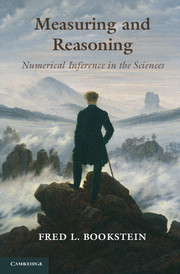Book contents
- Frontmatter
- Dedication
- Contents
- Analytical Table of Contents
- Preface
- Epigraphs
- Part I The Basic Structure of Numerical Inference
- 1 Getting Started
- 2 Consilience as a Rhetorical strategy
- 3 Abduction and Strong Inference
- Part II A Sampler of Strategies
- Part III Numerical Inference for General Systems
- Part IV What Is to Be Done?
- References
- Index
- Plate section
3 - Abduction and Strong Inference
from Part I - The Basic Structure of Numerical Inference
Published online by Cambridge University Press: 05 March 2014
- Frontmatter
- Dedication
- Contents
- Analytical Table of Contents
- Preface
- Epigraphs
- Part I The Basic Structure of Numerical Inference
- 1 Getting Started
- 2 Consilience as a Rhetorical strategy
- 3 Abduction and Strong Inference
- Part II A Sampler of Strategies
- Part III Numerical Inference for General Systems
- Part IV What Is to Be Done?
- References
- Index
- Plate section
Summary
Chapter 2 reviewed diverse aspects of consilience, the general principle by which agreement of numerical values or matching of numerical patterns is turned into evidence for scientific assertions. But except for one example in each of the preceding two chapters we have not yet dealt with the step even earlier at which potential agreements were made the focus of our attention: the step at which some “surprising fact C is observed” from which a novel hypothesis will drain the surprise. The present chapter closes the logical circle by a detailed examination of this process, the launch of an abduction. It will prove to rely as much on human psychology as on any formal properties of numbers and the symbolic reasoning they convey.
As in earlier chapters, the first section reviews one specific example, here the demonstration by the Intergovernmental Panel on Climate Change (IPCC, 2007) that the rise of average global temperature beginning around 1960 is very likely the result of human action. I pay some attention to intellectual history, to publication details, and to several associated ironies. Section 3.2 introduces Charles Sanders Peirce, 19th-century American philosopher, and then, intentionally climbing higher on the scale of abstraction, presents in some detail the general syllogism he discovered, of which the episode in the introductory section serves as a particularly shining, if anachronistic, example.
- Type
- Chapter
- Information
- Measuring and ReasoningNumerical Inference in the Sciences, pp. 73 - 112Publisher: Cambridge University PressPrint publication year: 2014



